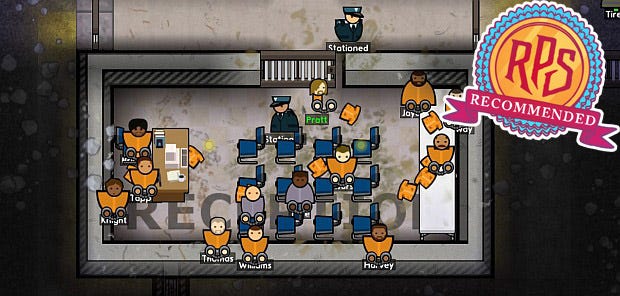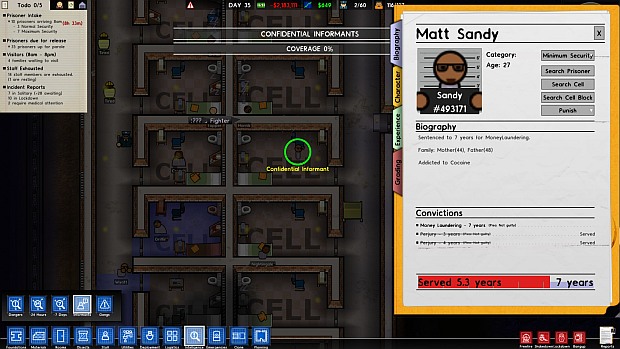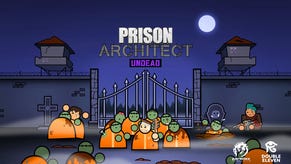Wot I Think: Prison Architect
Is 1.0 ready for civilized society?
It wasn't long after I attacked the officer that I was killed with a shotgun. A fight had broken out near the cell block entrance and my friend Tapper and I decided to use the opportunity to gain some prison cred by battering the guard who came to break it up. It did not go well. My character, Pratt, is now lying in the morgue and I have become Tapper, inheriting his body in a ghostly fashion. I am locked and restrained in my cell. Through the bars I can hear the faint sounds of a riot. I am sad to be missing out.
This is Escape Mode, just one of the features added to Prison Architect [official site] for its final release. After four years in development and alpha the game is finally out. Is prison the absolute LOL sesh it is made out to be in popular television show Orange is the New Black? Or is it more like the Midnight Express? Come with me, into this dark corner of the holding cell, to find out Wot I Think. Please mind the vomit.
You may not have heard of Introversion's prison sim, but only if you yourself have been in prison for the past half a decade. It is a game in which you lay down a prison piece by piece, from the armory and the cells, to the toilets in the cells, to the pipes that connect the toilets to the sewer, and so on. It plays a little bit like traditional management games and a little bit like PC gaming legend Dwarf Fortress. Thankfully, the creators have forgone the ASCII horror of the latter and given it a cutesy comic book art style. This sometimes clashes with the strangely serious tone of the introductory chapters, which see you execute a prisoner on death row by electric chair. These opening "missions" are called a campaign but they are more of a tutorial, easing you in and letting you play around with optional tasks at the close of each level.
And if ever a game needed a tutorial, it's this. PA in its final form is complex, refreshing and sometimes frustrating. It will take you hours to get to a state of semi-comprehension and days to fully understand every little cog of the machine. In fact, I still can't brave the use of logic switches or pressure plates, which can be used to micromanage every tiny movement of your prisoners and staff. I have just about got my head around installing a viable back-up generator and plumbing system, for when my primary power centre explodes and several janitors burn to death (this has happened twice).
That brings us to the core of what makes Prison Architect so appealing. Things can and do go wrong. A recently added events system throws disasters at you while you build. So you may be in the middle of scheduling a drugs programme to relieve addicts of their dependencies when suddenly the mayor calls you and tells you that a news story has broken about visitors smuggling heroin into a nearby prison, and we can't be seen to be complacent. Shut down your visitation rooms or face fines, he will say. And you will look at your prisoners, trapped in their cells, shouting about their families, and wince.
Sometimes multiple things will go wrong at once. A fire broke out in the central power hub of my facility, knocking out both water and power to the maximum security wing. It was 2am in the morning and the firefighters I called in worked through the night to douse the flames. But at the same time, the mayor called me and told me casually that I was to remove all the weights benches from the prison because of public pressure. In my mind, I threw the phone to one side and thought: "I will do that later, for God's sake, we are on fire here." But as the dawn broke, power and water had still not been restored to the maximum security wing. The kitchen staff were unable to cook breakfast and as the prisoners woke up and roamed from the showers to the canteen, all they found were empty serving trays. The riot began almost at once. Five chefs were murdered.
Then the mayor called. I was being fined, he said, because I still hadn't removed the weights benches. "And you will continue to be fined every day until they are removed."
I do not like the Mayor.
Problems and crises like this happen constantly. Prisoners are stealing poison from the cleaning cupboard, others have started digging a tunnel, and I am so understaffed that dead bodies of murder victims are being left to rot in the yard. But this feeling of constant pressure never feels stressful or irritating. And good management in an emergency makes you feel like a hard-headed veteran of the justice system. One day, a doctor called to tell me three inmates had contracted a contagious disease and needed to be isolated. As they slept, I examined every inmate with a probing mouse hover until I found the three poor souls. I called in some paramedics (not wanting to risk my own staff doctors catching and spreading the disease) and quickly treated the ill prisoners. Then I force-locked their cell doors. In the morning, when all the other cells automatically opened and everyone went to the showers, the three sick men shambled around behind bars. They had been treated and were recovering but they were still infectious. I was very pleased that only one of them started trashing his cell in protest and had to be beaten unconscious. Ultimately, they all recovered and what could have been a disastrous contagion was suppressed on day one. I was very happy with my cool handling of the crisis. The mayor did not call to congratulate me.
The events feature is not the only fresh thing since the last time I tackled the penal system. You are now able to recruit informants to build up intelligence on your prisoners. Using a network of snitches lets you see hidden or incoming contraband and examine the traits and behavioural quirks of many of the men. Some may be tough, able to take a thrashing more than your average con. Others might be stoical, which means they won’t become “suppressed” when put in solitary. It's questionable how useful this information is, given you will usually be too busy with larger things to micromanage the interactions of each tiny orange sprite. But it is good to see anything that gives the wee men some semblance of character because, sadly, this is one of PA's flaws. The prisoners may have traits, but how these traits affect day to day life isn't really noticeable when the game is played on larger scales.
It makes me think of the lesser-known Rimworld, which matches the aesthetic of Prison Architect (eerily so). It's a management game about a keeping a few space explorers alive after being marooned on a faraway planet and it too owes a lot of its ambition to king of games Dwarf Fortress. Sometimes people will come and attack your colony. If you knock an attacker out, you can capture them and after some time convince them to join your own burgeoning settlement. Over time, your colony grows. Escape pods fall from the sky. Cryogenically frozen inhabitants are found buried under layers of rock. One by one, your camp becomes a little village. It is a slow growth and each new member feels like a new character being introduced into this ridiculous space opera you are creating. They can be depressive, ill-tempered, drunks, even missing some or all their limbs. And each characteristic is visible and influential. People with missing limbs walk and work much slower. Depressive colonists refuse to work, drunks go on benders, and traumatised veterans walk around in a tragic fugue state. More than this, you will recognise them by name and try to keep them all in good spirits. My point is, you get to know your little community. With Prison Architect, I never really get to know anybody. You can dial back your intake and make a small communal prison if you really want. But the management aspect just feels so much better when you build as big as your cashflow allows. The sheer number of inmates makes it unlikely you will ever really care too much, or notice when they do something hilariously in-character.
All this said, it was still nice to have a network of touts working for me against their own criminal compadres. My very first informer, a money launderer called Matt Sandy, is the closest I got to being interested in an inmate as an individual. It was exasperating to see him arrive in solitary again and again for violations of contraband. But I suppose he had to keep up appearances. And, yes, his cocaine habit. To make things more varied, some prisoners may also belong to a gang. This seems to be a very slow-burning feature however. So slow-burning that it seems to neutralise whatever effect gangs were supposed to have. New members come along so seldom it took about 10 hours of play before there were two distinct (yet nameless) gangs. One of which only has a single member. There has yet to be any gang-related violence or trouble.
Less has been added on the staff side since my last prison. I have employed several of the dog units to catch out ne'er-do-wells, and I have used the patrol system added last to mark paths for them to follow. They are walked around the fenced buffer zone outside my perimeter walls to sniff out any tunnelling going on underfoot. Reluctantly, I also installed armed guards in my maximum security wing. Right now they are only using tasers and I have promised myself never to use the blood red "Freefire" button in the bottom of the screen, which allows them to use lethal force on prisoners. As far as I’m aware all these roles have been in the game for a while now. I could have explored the death row options, which is more recent. But I find something about having an electric chair in my prison instinctively distasteful. Which is strange, considering my prisoners die on a daily basis from beatings and fights, and I suffer only the most fleeting frown.
For a while, after building my back-up generator, I found myself at a loss. What more could I do without approaching the dreaded logic circuit mechanics. I was worried that PA, while a great game, would have too early a turning-off point. The moment I rediscovered my admiration for its complexity was when I used the intelligence screen to check on the contraband that seemed to be flowing into my prison without end. At this point I was performing nightly shakedowns on all cells and prisoners and discovering huge amounts of weapons, tools and narcotics. It was leaving my staff exhausted but I had no other option. In one instance I discovered over 100 sets of prison keys had been stolen from a security room with a missing section of wall. The inmates were able to go anywhere they wanted and smuggling had become rife. I sealed up the wall and declared war on contraband.
The intelligence screen was going to be my friend in this endeavour. It includes one of my favourite features. One tab displays all the contraband that has been confiscated or discovered in the last 24 hours, another in the last 7 days. It also highlights where it was found on your map. Hover your mouse on this and a giant red scribble appears. This is the route the item has taken through your prison from the moment it arrived, or from when it was stolen from a genuine source, like the infirmary or kitchen.
I traced most items back to new prisoners, who were not being thoroughly searched. The unsecured storage room was also a treasure trove of drills, hammers and screwdrivers. I invested heavily in metal detectors, which I installed over the main prison entrance, cell block entrances and canteens. As well as suffering a massive power outage because of the necessary electricity, there was also a huge spike in numbers of prisoners sent to solitary, as prisoners were found smuggling items faster than the guards could process them. But every problem is also an opportunity. I recruited dozens of informants in the wake of the contraband crackdown.
The supply of weapons and tools dropped dramatically and the tunnel problem dried up overnight. 10 prisoners had escaped my facility in total, I had accounted for 9 of them who used tunnels. I speculate that the tenth had simply waited for a moment the guards weren't looking and escaped out the front door, with one of the 100 missing keys. Whoever that was, I salute him.
Yet looking at the intelligence screens I found that, while the presence of weapons and tools were dwindling, supplies of narcotics and alcohol were skyrocketing. I could also tell this because alcohol and drugs were all anyone in my prison was talking about (the prisoners have little speech bubbles). The floor of every room in the prison was also caked with thick layers of vomit. Intoxication and alcoholism proved to be a bigger epidemic than the would-be doomsday disease I had averted just weeks before. I went back to my trusty red squiggles and discovered the source of the problem.
Somebody was throwing things over the walls.
I had seen prisoners walking along the perimeter wall before and noted this as "suspicious". But with the tunnel problem so prevalent I put this down to escape artists scoping out their exit routes. In reality, a handful of smuggled phones were allowing prisoners to co-ordinate with some unseen agents from the outside, who were tossing drugs and drink over the wall. It was a simple and elegant solution to their metal detector problem. That night, I got to work. When the prisoners woke up, they discovered an interior fence all around the perimeter wall. Shortly afterwards, several prisoners entered withdrawal.
The alcoholics were having it bad. There was a problem. Nobody was attending the addiction meetings I had scheduled. I tried for a long time to understand what I was doing wrong. Did I have a room for it? Had I scheduled it properly? Were there enough seats for everyone? I even speculated that the reason this support class had stalled was because the freshly-hired prison psychologist was refusing on the grounds that the prisoners had murdered the last one during a particularly emotional therapy session. And while this must have been very cathartic for them, it made me worry I had no chance of reviving the program. I fired the psychologist and hired a new one. But he too did nothing. The therapy program was just broken.
This is another of PA's unfortunate shortcomings. Despite the years of craft and attention, it still entertains the odd bug. One annoying glitch meant that several dead bodies were not being put in the morgue or collected by medical cars when they were supposed to be. Instead, each body had attracted its own guard, who would approach the corpse, pick it up, set it down immediately, walk away, then stop. They would then re-approach and do the whole thing over again. It was very comical seeing these officers become permanently enraptured with their cadavers but it also meant that I was noticeably short-staffed until the bug magically disappeared (an update to the review code? A simple matter of time?). While a bug has never ruined my prison, they are frustrating to deal with. Especially when part of the appeal of running your prison is about wrestling to maintain total control.
Let's talk about escape mode. It feels simultaneously like an excellent addition and a tacked-on one. You can play this mode on your own prison, or grab one of the mad supermax creations of the community and lose yourself in that. You arrive on the bus to be escorted and processed according to however the player has set up the prison. Playing on my own map, I was left in the reception for over 20 hours before I decided to process myself. I got into the store room and stole a hammer and wooden pickaxe. In the evening I began a tunnel, but accidently surfaced too soon and was put in lockdown as workmen sealed up all my hard work. Thankfully, you can spend "cred points" to skip the time spent in your cell as punishment. The idea is to get some cred by beating people up, recruit some dudes as help, and try whatever method you can think of to bust out. What I like most about this mode is the simple ability to explore and see your creation from the inside. Zoomed this closely in, the sounds and sights of the building become clear and significant in a way that isn't possible when you play as an omnipresent manager floating in the sky. Inmates howl, jail doors clang, guards bark orders and talk over their radios. Even if you only spend a little while in escape mode, it will be time well spent. Speaking as an RPS diarist, it is the stuff dreams are made of.
That's the ultimate point to make about PA. Even if it doesn't fully satisfy my desire for followable characters, it is still an excellent story-making game. Disasters are part of daily life, death and drama occur alongside logistical cock-ups, leaving your prison without flushing toilets for days. Riots start over the dumbest oversights, and cute little men in orange uniforms barricade themselves in kitchens, murdering all the cooks. You can lose control of an entire cell block and have to call in the riot police. Once, I had to call the fire brigade three days in a row. It is the only management game that has made me feel sheepish.
There is only one major difficulty for any reviewer of Introversion's incarceration fest. It isn't deciding whether or not to recommend it. I very much do. It is that anyone who is interested in Prison Architect is already likely to have picked it up. Many of us have already had 36 months of early access to amuse ourselves by building giant toilets with some prison beds inside. And those who haven't got it by now may be quite happy to continue ignoring it. I think this would be an enormous shame. If this is you, I want to tell you that it is a game worth playing. If you already have a copy, however, I want to tell you it is worth going back to, even if how much you get out out of it will depend on when you last played. Three years ago? Absolutely, get back in there. There's a lot to mess around with. One year ago? I don't know. At the very least, it is worth firing up escape mode and throwing yourself into an old prison you made, as an exercise in memory and nostalgia. Trust me, I've been there.
Just try not to get yourself killed.
Prison Architect v1.0 is out now and available from Steam, Humble, or direct from the developer.


























